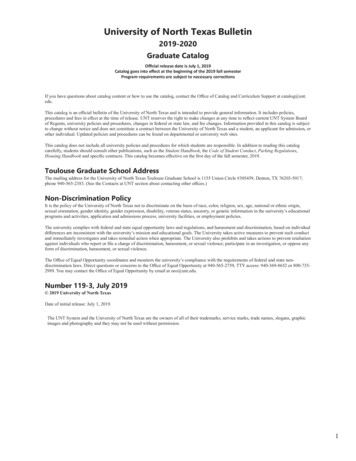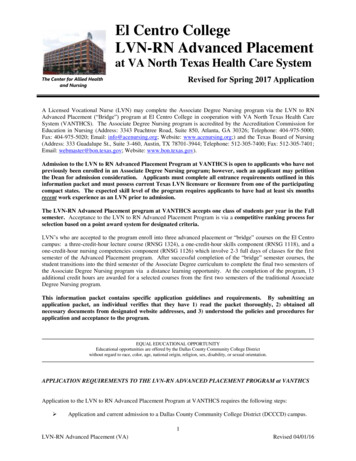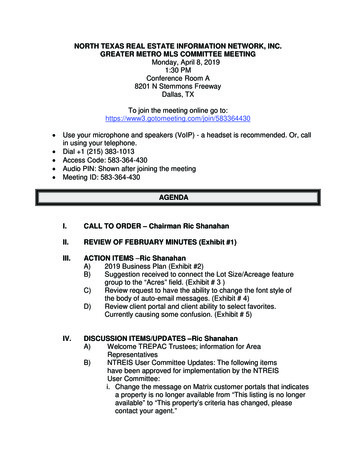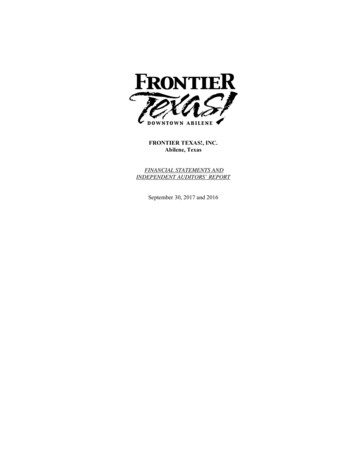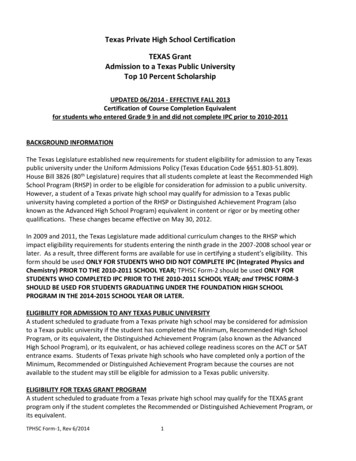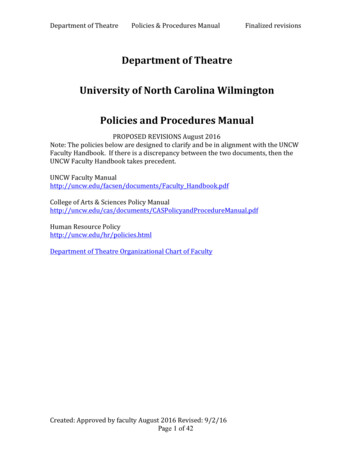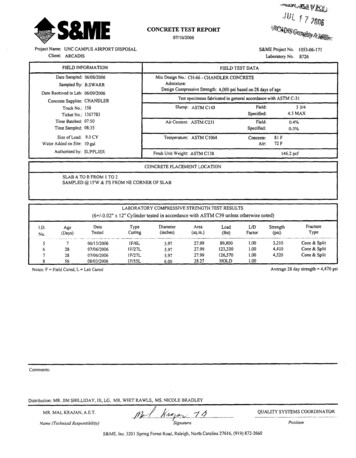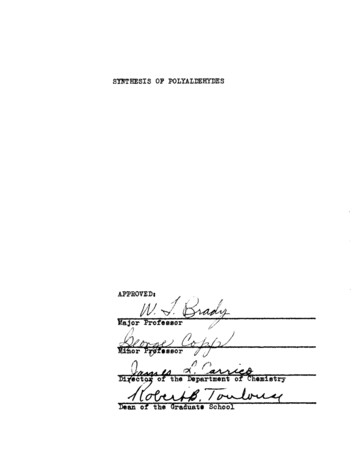
Transcription
SXBTBB818 OF POLYAHEHYD1SAPPROVED!fcjjor P r o f e s s o rWPiwesiorD i e c t o t h e * I3#p 3 VCcrtrt J \ /Dtam of tli« Graduate School
SYJJTHBSIS Of mTAIEEHTBESTHESISPrecented to the Graduate Cornell of the%Iforth Texas Stat tJniYeraity in PartialFulfillment of the HequixementsPor the Degree ofMASTER Of SCIEKCE%Hubert Bonald O'Neal, B# S Danton, TexasJune, 1964
PREFACETha polymerisation of aldahydaa has toon a racant andintar««ting davalopnant In tha fiald of polymar aynthaeaa.Thaea davalopiaanta hara includad tha polyuiriaation of bothmonoaldehydes and dialdahyias to high aolaemlar weightpoly»ers Part one of thia tha sis ooneama tha polyaariaafcilityof aomeoc9/9-unsaturated monoaldehydes and also ralataa thasynthesis of soma new poly aldehydes whieh harra not haan ra portad in tha literature*Part two ooneama tha polymerization of glyoxal, thesimplest dialdehyde, d tha structure elucidation of thianew polysar*iii
TABLE Of C0HTEH2SBftgtMST Of TABLES,. . .LIST Of ILUtJSTBATIOKS rimm iCfflLPTSRI,UfTBOKJCTIOFfiftnifiXi A&TJun# fJSJLIr(ItAXUpliIII. . . . . # # * # # * #1»y (KSS0LTS AND COHCLUSIOIfS . . . . 12IHTBOHJCTIOlf.15PART I ICHAPTBfiI,ii* mmxmALIII.toHISUXffS AID C0RCLDSI0H325APKBJTDIX . .32BIBLIOGHAPHT. . 36It
LIS? OF 2ABLE2fabl X«tag RtsuXta of Polymerisation Attempt . * « *12
usi of ihmmmnmsfiguret«Polj-glyoxalo . . . . . . . . 332*AolU SytateA Boljrglyoxsl . . . . . . . .3-Ac«tyX*ttd Polyglyoxal « * * # » # « * . 35Ti#34
Ml 1
CHAPTER Ixifsowcficmformaldehyde h u been encountered la a pelyaerio form,ever ainee it earliest preparation by B a t l t m in 1859 (3)«The typical formaldehy&t polymers are low molecular weightsubstances which decompose when heated*The structure ofthe polyf ormaldehy des remained obscure until the verythorough and skillful investigations of Staudinger (10)*Staudinger established that the polymers are comprised ofsieleeuXar chains of polyexyaethyleite units*Alio, Staudingerwas able to prepare formaldehyde polymer with molecularweights that exceeded the typical by a considerable degree.This was accomplished by allowing purified liquid formaldehyde to pclymeriss in bulk at -80 C. The end groupsof the polymer were shown t be predominantly hydroxylthue having the general structure shown below.10-{GH2-0-)aCHg-0HInyestigations by E. X. dm Pont de Keaours & Co. researchers over the last twenty-three years have led to thediscovery of ways to polymerise formaldehyde to a highmolecular weight polymer having high thermal stability.The success of the stabilisation involved acylation of theunstable hemlacetal end groups (9).1
?he polyformaldehyde currently producedfeyB* I* 4uPont 4# lemour & Co. is ac tylat d polyforiaiiiaehydt andis soldrnidsrth trad name of "SeXrin". Selanea alsoprodue«e a polyformaldehyde which is sold und#r the tradett»«o »c loon*« This polyforualdehyd is stabilised hyc polyj ri atioa with a email a&ount of a cyclic th rsuch m ethylene oxide (2).Polymerisation of aliehyit hightr than formaldehydeto high molecular weight crystalline polymers wa r port din 1960 by Yogi, Satta* «»* fvantoum (it* 8» 4)*polyald hyd « w r prepared wploylns an orga»o* t lliecatalyst at -78 C* in an in rt hydrocarbon « lT«at* fh polymerisations wer carried out und r strictly aoafegrtoott*conditions. Solid polymers wer obtained which wer highly crystalline and thermally unstable* fhie type ofpolymer Is in contrast te the predion , typical polynerswhich art lower in »ol cular w t§ht aai ar anorphoua*Th high molecular weight crystalline polyacetaldehyd 1 insoluble in all th cosaaon organic solvent and is toughand fiexlbi , llatta ha « tahU h d that th » poly* r»ar ieotaotio wh n prepared at low temperature and in th pr nc of st r o«p clfio cataly ts (7)* Th atruotur of th hi«h r polyaldehydes can b represented by th following repeating unit.iR
latta (6) to# proposed a mechanism for the anionicpolymerisation of aldehydes which is illustrated withacetaldehyd ad an aluminum trialkyl IHHCH--C.0 4- Al-HJHaiCB -»e KAl3 iiiaCH, C*0\ A1 R3a.\aHiCH.-CaOH1HiCH.-C*"»0**CU" 0"*A13 iiiaea, a1aHi OwCWCH — " C H , - C » G - A l 7*1aHch.-C»O3 iaHHiEi AJLich. CH 1In order to substantiate hie proposed ateehaniamlatta conducted 8 m experiments employing labeled ethylgroups In the organoaetallic catalyst.It was reportedthat in the synthesis of isotactie polyaldehydes withAl(CgH )g 0C2H ) as catalyst, radioactive polymers wereobtained only if the ethoxlde group contained labeledcarbon atoms. Konradloactive p#ly @rs were htained withthe use of labeled trlalkylalusdnum mcatalyst Thesereported results certainly agree with the above proposedmechanism involving an aUsoxid# transfer#fmrukftwa has proposed a slallar mechanism wherebythe active species la the polymerisation of am aldehyde
by an organo*etallic compound It the correspondingmetal' alkoxide (4) *1i1**C«0 B*KtH 1i iBWCW O»C*»0»»MeI IB' H1B»C»Q1R-C-. »KeI1*H E IiiH.*"* O**** 0* r *0**» 0 M i i1* H HacThis mechanism is substantiated by the fact thatsome metal alkoxides were found tofear#catalytic activityfor the polymerisat ion of aldehydes.At the time this work was initiated, only a limitednumber of aldehydes hafi been reported aa being polymeriaable to high molecular weight crystalline polymers. Shesealdehyde in elude the normal aldehydes through octanal mwell as trichloroacetaldehyde» phenylacetaldehyde , isobutyraldehyde, and. 3 ethoxypropsnal* Share is m noticeablelack of m aldehyde containing conjugated unsaturation suchaa bensaldehyde, crotonaldehyde, furfuraldehyde, or clnnamaldehyde, Also, a cyclic aldehyde had not been reported asbeing polymeriaable» A review of the developments in thefield of poly aldehydes has recently been made by Bevington (1).The polymerization ef unsaturated .aldehydes is mentioned inthis review and it is indicated that such aldehydes polymerise , but generally the reactions involve the ethylenic
double bond rather than the carbonyl bond*Alao, Koralhas r%mmtly reported the polymerisation of crotonaldehyde by Means of certain tertiary phoaphinea to aTinyl-type polymer (55*flier were two ob ectivea to thia project.The firatobjective was to determine if the carbonyl functionalityof maldehyde containing x ,/s -uaaaturation could bepolymerised by an organoiaetallio catalyat, auch aa alu*im*atriethyl wider the usual conditions t a high molecularweight cryetalline pely*er.The aeoond objective was tosynthesize new polyaldehydes that had not been reportedin the literature*fiie following aldehyde a were selected bic am # theywere readily available and they would be expected tofulfill the above described objectives! srotosaldehyie,furfuraldehyde * einnaaaldehyde, hydro ciimaaeldehyde,bensaldehyde* oyolohezaneearboxaldehyde, and -oyclehexene-1«carboxaldehyde
CHAPTER BIBUO&HAPH*1.*Btvlfigtom#"Polyatrs ftnra Aldahjraee.," British?la»tloa. XXXV (f.touwy 1962)., 75-79.2.B r i t i s h J a t » n t 9 0 3 , 6 6 1 , C « 1 k m m C o r j o r m t i o a of I v r t e s(1 §§§).# 3*Btrfclarov, A . , wm *ar I n i g , D e r i v a t « A * * Jo UaetlMrl«n8, sAffililJtt J i , O W t f r(Mty t85&)». 2 4 2 - 2 5 2 ,4*Fujikawa,* J » r S&eguaa, T . fJ a a i * H*f and F a l i , Y # MkSttomtohH« r K a w a s a k i , A , ,Cry taXXime P o l y a l A t h y A a a , "tta x r a (April 1960),5*K o r a l , J. S* :f "Crotonaldthydt Polymerisation,M J o t m r n lM M m KM f M f « X {0ei lMir 1 § 6 2 ) f S 3 7 - S l l r6,Natta, &.f "3t«r*o»p»cifie M l y m r m t i m & § & P o l y m e r SelincAk X I V I I I (S»e«Brt «r 1960) # 21!8*Hatta, *,, Ma**aatit IV,#iKBailTijLf# a.,Ur* CorradiniuOXTAQtMS&fJfcVf ana&2ia fiae»ll * 6 8 i #f I,X« fW#"I»otaetie 4 - P' " f , W o t i w -? * -m w - 4XXX«r(I ?9lo), 15n5l:" ' «a .10#11.4'Schwtit8arf C* S*« Kaeltonald, 1* l i f aai ftmifwem.* #. 0«,jfraaiiJL M i m M f i , .Batottr Scl»no«. 1 (1959)» 15&* ' " or«mi8chan I t e t e S a a s B #T«cl, 0,, "Th« PsXywrlaatisn of AX4«iqr «(," J m i r n u l of3cl«nc«. JXVI (3«pt*sb*r I960), 261-86?.
CHAPTER IIWWHtlWffiAffhe aldehydes to be studied were commercially available but it wa necessary to distill them *1 obtain a, highdegree of parity*The hydrocarbon solvent * n»h#xanet wa .eosaaereially available hat it was rigorously purified hefore use#Aluminum triethyl v u selected at the catalystfor this study and it ma purchased from Texas Alkyls asa 25 per cent solution in n hexane*Infrared data were obtained hy a Parkin-Elmer ModelS3? Grating Infrared Spectrophotometer*The samples wereprepared as f&Jol lulls and ran with tedium chloride discsat a slit setting of 800, X-ray diffraction studies todetermine the crystallinity of the polymers were obtainedwith a Phillips Electronic Instruments X Hay DiffractionUnit using a 114*6 am. camera.Typical Polymerisation ProcedureThe aldehyde monomer was distilled under a nitrogenatmosphere on a 30 plate Oldershaw distillation columninto a 300 ml., three-necked» round bottom flasksAbout15 ml* were collected in the polymerisation vessel. Theflask was equipped with a stirrer and a nitrogen inletand outlet#A 100 ml. portion of n»hexane» which hadbeen refluxed over sodium wire for eighteen to twenty7
hour and then dietilled ma 30-plate Olderahaw colusa,was addtd to the no nomer# I ha aldehyde eolation was cooledwith stirring to 73 C* by iumersi&g the flaak 4m a dryioe-»aeetone feath. A 1*5 al* (0*00236 sola) portion ofaluminum triethyl (25 par cent isolation in n-hexane) wmeadded to the cold eolution %maims of a hypodermic ayringe*All operationa were conducted under a dry nitrogen atmou-phara. If polymerisation occurred, it generally did so "within fire to tea minutes as' evidenced "by an increase inriaooaity and eventual gelation. ' If there was no evidenceof polymerisation in thirty minutes, another afnal oatalyatcharge was added and the stirring continued in the Old fortwo to three hours#In those runa wher polymerisation didnot scour, a control rm was aada eaploying isotoutyraldafcyAeto check th parity of the eolvant*Polymtrii&tion of Bydroeinna aiaehydtA 16 al» 16*35 g*§ 0*122 sole) portion of hydro-cinnaaaaldehyde was vacuum distilled, h*p* 114 C. at 15ma* pressure, on the 30-plate Olderahaw coluim into a300 al*, three-necked reaction flask*A 100 al* portionof dry n-hescane w m traneferred to the flaak under anitrogen ataoaphere and with agitation tha mixture cooledto -70 C, in m dry ice-acetone hath* The monomer frozecreating an agitation problem*fhe mixture wm allowed towarm until a haterogeneoua slush waa obtained*At thiapoint 2*0 al* (0.00315 sola ) of 25 par cant aluftitiua
triethyl in i s m i were added % means of a hypoderaiosyringe* After seven to ten minutes, polymerisation wasevident due to the fonaatieii ef a hard gel in the bottom f the flMdu A 75 *! portion of 5 per @*ot aeetylacetonein bmtaael was added to destroy any residual catalyst asadale# to idS la the removal of the catalyst* The polymerwas isolatedfeyfiltration and then washed with acetonein an exploeioa proof Waring Header sad filtered* Thiswas repeated three tiaes and then the pelymer was dried ina vacuum oven at 60 C, for twenty to twenty-four hour . 5here was obtained 5.9 g* of a whit# solid, this eerresponds t a 36 pea? cent conversion. An infrared spectrtwshewed aeetal absorption in the 900 cm,""1 to 1200 esu 1range and the absence of earbonyl absorption at 1730 em. 1.X-ray diffraction data indicated the polymer to he crystalline.Polymerization of3-»Cyclohexene 1-CarboxaldehydeA 13 a&« (12.4 g»t 0#113 wile) portion of -oyelo hi'xene- l«*carboxaldehy de was vacuum distilled b.p,C,at 17 m» pressure, en a 30-plate Oldemhaw e t a andtransferred under nitrogen to a 300 1. reaction flagfe*4 1 0 s&» alifttot of dry a-hexane was transferred to theflask and with agitation under a nitrogen atmosphere# themixturewas cooled te -78 C» in a dry iee-acetone hath*fhe catalyst, 1.25 al. (0.00190 stoles) of 25 per eent
10aluminum triithyl in n-hexane» was then added hy a*ane ofa hypodermic eyringe.Gelation occurred after eeven to tonaliurta* but the reactioB was continued at low temperaturefor two hour*. 2h* polymerisation wae t«ndaatt.& hy th«addition of 75 «1» of 5 per cent acetylaeetone in butanol.fh« polymer wae filtered, washed four timee with acetone,and dried in the vacrn oven for eighteen to twenty hoursat 60 C*A yield f 3.8 g. of dry polymer- mmobtained. Thiscorresponds to a 31' per cent conversion "based on the mono- MBT weight. Infrared data showed acetal absorption* andthe alaaenee of oarbonyl absorption#X-ray diffractionetudiee showed the polymer to be crystalline.Polymerization ofOyclohexanecarboxaldehydeAn 1 ml. portion (17* g*j 0.161 moles) of eyelo*h«x»»eearbexaldehyde «is vacuum distilled b*p. 75 0, at20 m * pra»«eres on the 30-plate Olderehaw colusm into a300 a U reaction flask, A 100 ml. portion- of toy n-hexanewas trs&* erred to the fjasfc and under a nitrogen tftao**phere the mixture was celled with agitation to -78 C4in a dry ice-acetone bath. A 1,25 »1* (0.00190 mole) portionof 25 per cent aluminum triathyl in n-hexane was then addedlay means of a hypodermic syringe# elation occurred inseven to ten minutes but stirring under nitrogen in theoold was continued for two hours*The polymerisation was
11terminated % the addition of 75 » ! of § par oant aeetylacaten# i n butanol# ' She f t l y w i r wan f i l t t r t d , wMfcti thraa .tines withand dried i n si Taemm ovati at 60 0*f o r twenty-two feoura#ffatra was obtained 6#9 g. f dry pely&ar eerrtfiipemdingt e a 41 p#r tut eonrarsion.l a f r a r t d data stewed aoatalabsorption and tha abaance of carbooyl absorption*X*»rayd i f f r a c t i o n stmdlta indicated tha ptly&tr; to ba axjatdXftaft*
e i & i f l iR E S U L T Sf l i #t h #m e n t a ls e l e c t e dp o X y m r i a a t l o as s c t l o x up o l y m t r i z a t i o nG O R C L U S I
atmosphere on a 30 plate Oldershaw distillation column into a 300 ml., three-necked» round bottom flasks About 15 ml* were collected in the polymerisation vessel. The flask was equipped with a stirrer and a nitrogen inlet and outlet# A 100 ml. portion of n»hexane» which had been refluxed over sodium wire for eighteen to twenty 7 . hour and then dietilled m a 30-plate Olderahaw colusa, was .

